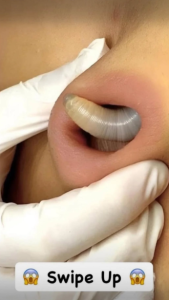
🔴 Red Dots on the Skin: Causes and What They Might Represent
If you’ve ever noticed small red dots on your skin—whether they’re flat, raised, itchy, or painless—you’re not alone. These spots are common and can result from a wide range of causes, from benign conditions to underlying health issues. Understanding what these dots mean and how to respond to them can help you determine whether they require medical attention or are simply cosmetic.
1. 🔬 What Are Red Dots on the Skin?
Red dots on the skin are known as macules or papules, depending on whether they are flat or raised:
-
Macules: Flat, red areas without elevation.
-
Papules: Small, raised bumps that can feel solid.
They may appear singly or in clusters, can vary in size and shade (from bright red to purplish), and may or may not be itchy or painful.
2. 🧬 Common Causes of Red Dots
✅ 1. Petechiae
-
Description: Tiny, pinpoint red or purple dots that don’t blanch (turn white) when pressed.
-
Cause: Small blood vessels (capillaries) breaking under the skin.
-
Possible Triggers:
-
Coughing or vomiting hard
-
Physical trauma (tight clothing, weightlifting)
-
Infections (e.g., meningococcemia, viral fevers)
-
Blood disorders or medications (e.g., anticoagulants)
-
🩺 When to worry: If petechiae spread quickly or are accompanied by fever or fatigue, see a doctor immediately.
✅ 2. Cherry Angiomas
-
Description: Bright red, round or oval growths made of small blood vessels; often smooth and raised.
-
Cause: Unknown, but commonly appear with aging (usually over 30).
-
Harmless: Generally benign, though they can bleed if scratched.
🩺 Treatment: Not required unless for cosmetic reasons (laser removal, electrocautery).
✅ 3. Heat Rash (Miliaria)
-
Description: Tiny red spots or clear blisters in clusters, often itchy or prickly.
-
Cause: Blocked sweat ducts due to heat and humidity.
-
Common Sites: Neck, back, chest, under breasts, groin.
🧊 Relief: Keep skin cool and dry; wear breathable clothing.
✅ 4. Allergic Reactions / Hives (Urticaria)
-
Description: Raised, itchy red welts or dots that can come and go.
-
Triggers:
-
Foods (nuts, shellfish, eggs)
-
Medications (antibiotics, NSAIDs)
-
Insect bites or environmental allergens
-
🩺 Treatment: Antihistamines (like loratadine), avoidance of known allergens. Seek emergency help if you experience trouble breathing or swelling of the face.
✅ 5. Keratosis Pilaris
-
Description: Small, red, bumpy “chicken skin” on upper arms, thighs, or cheeks.
-
Cause: Keratin buildup blocking hair follicles.
-
Harmless: Not dangerous, just a cosmetic issue.
🧴 Care: Moisturizers with urea, lactic acid, or salicylic acid may help.
✅ 6. Insect Bites
-
Description: Localized red bumps that may itch or swell.
-
Common Bites: Mosquitoes, bedbugs, fleas, mites.
-
Pattern: Often in a line or cluster.
🩺 Watch for signs of infection (pus, increased redness), or allergic reactions.
✅ 7. Dermatitis or Eczema
-
Description: Red, inflamed patches that can form bumps, flake, or ooze.
-
Types:
-
Atopic dermatitis
-
Contact dermatitis (from irritants or allergens)
-
🩺 Treatment: Moisturizers, corticosteroid creams, antihistamines.
3. 🧪 Less Common But Concerning Causes
⚠️ 1. Vasculitis
-
Description: Inflammation of blood vessels causing red or purple dots.
-
Symptoms: Pain, fatigue, fever, joint pain.
-
Cause: Autoimmune diseases (e.g., lupus), infections, medications.
🩺 Urgency: Needs medical evaluation and possibly immunosuppressive therapy.
⚠️ 2. Thrombocytopenia (Low Platelets)
-
Description: Petechiae may signal this blood-clotting disorder.
-
Cause: Immune conditions, infections, chemotherapy.
-
Clues: Easy bruising, gum/nose bleeding, fatigue.
🩺 Diagnosis: Blood test (CBC) and specialist referral.
⚠️ 3. Meningococcemia
-
Description: Rapidly spreading purplish-red petechiae and rash with fever.
-
Cause: Bacterial blood infection—life-threatening.
🆘 EMERGENCY: Requires immediate antibiotics and hospitalization.
⚠️ 4. Skin Cancer (Rarely)
-
Description: Red lesions that persist, grow, or bleed (e.g., basal cell carcinoma, Kaposi sarcoma).
-
Clues: Doesn’t fade, bleeds easily, irregular borders.
🩺 Check with a dermatologist if a red dot is suspicious or changing.
4. 🧭 When Should You See a Doctor?
You should seek medical attention if:
-
The red dots don’t go away after a few days.
-
They’re spreading rapidly.
-
You develop fever, fatigue, bleeding, or bruising.
-
The red dots are painful, blistering, or crusting.
-
You’re immunocompromised, or taking medications like blood thinners or chemotherapy.
5. 👩⚕️ Diagnosis and Treatment
A healthcare provider may:
-
Take a detailed history: recent illness, medications, exposures.
-
Perform a skin exam: pattern, blanching test, location.
-
Order tests:
-
CBC (complete blood count)
-
Coagulation panel
-
Allergy testing
-
Skin biopsy (if suspicious)
-
Treatment depends on the cause:
-
Benign spots like cherry angiomas → no treatment needed.
-
Allergies → antihistamines or corticosteroids.
-
Infections or systemic disease → antibiotics, antivirals, or specialized care.
6. 🧴 At-Home Care & Prevention Tips
For mild, non-serious red dots:
-
Keep skin clean and moisturized.
-
Avoid scratching to prevent infection.
-
Use fragrance-free skin products.
-
Avoid known allergens and irritants.
-
Protect your skin from extreme heat and sun.
7. 🔄 Summary Table
| Cause | Appearance | Common Location | Treatment |
|---|---|---|---|
| Cherry Angioma | Bright red bump | Torso, limbs | Cosmetic only |
| Petechiae | Pinpoint red dots | Anywhere | Evaluate urgently |
| Heat Rash | Tiny itchy dots | Folds, under clothes | Cooling, powder |
| Allergic Rash | Itchy red welts | Random | Antihistamines |
| Insect Bites | Clustered bumps | Exposed skin | Calamine, ice |
| Eczema/Dermatitis | Red scaly patches | Hands, arms, face | Creams, moisturizers |
| Vasculitis | Purple dots | Legs, arms | Medical care needed |
| Skin Cancer | Non-healing red spot | Sun-exposed areas | Dermatologist eval |
🧠 Final Thoughts
Red dots on the skin are usually harmless, but they can sometimes be the first sign of something more serious. Knowing the difference—and paying attention to associated symptoms like fever, bleeding, or rapid spread—is crucial.
If you’re ever in doubt, consult a dermatologist or primary care doctor. It’s always better to check early and be safe, especially when the skin gives us signs of something brewing beneath the surface.
